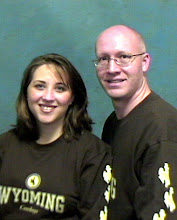Here in this photo you can see the small amount of comb the bees had built on this frame. There were four frames with about this same amount of comb. I was hoping for more.
Once I got through the super I started into the upper deep hive body. I could immediately see that the bees had filled out all the deep frames. The first frame was really cemented in place with wax and propolis. That combined with the fact that it was full of nectar and capped honey, which makes the frame surprisingly heavy, made it difficult to remove from the hive. You are supposed to carefully pull the frames straight up so you don't damage the comb. Well, as I wrenched the frame loose from the wax and propolis, the frame twisted sideways as I pulled it up. Besides this, there was a piece of burr comb on the side of the hive facing the frame. As I pulled the frame out at a crooked angle the burr comb scratched along the honey comb on the frame and pretty well mangled a big chunk of comb. I pulled it on out as it was dripping with honey- I bet a couple cups of honey dripped out. I captured some of the drippings- just enough for everybody in the family plus one neighbor kid to have a taste. Mmmm- Delicious!

Here is a shot of one of the deep frames with mostly capped honey and some open cells full of nectar toward the bottom.
Another frame with capped honey on the top half and some capped brood in the bottom half. When we first started I worried that I wouldn't be able to tell the difference between capped honey and capped brood. The difference is obvious, isn't it?
Once I discovered that there was plenty of capped brood and new eggs in Virginia I figured that the queen was doing well. I don't know what else I could accommplish by going throught he rest of the hive except disrupt the hive operations so I put things back together and didn't bother inspecting the bottom box.
Georgia's hive still had it's top hive feeder and the bees had been taking large amounts of sugar syrup. I removed the feeder and looked down into the the deep hive body and saw that the bees had finished drawing comb on all of the deep frames. As I started the inspection I found that the bees had not filled all of the comb with nectar/sugar syrup, but they were making progress.
As I came across frames with capped brood I saw something I had not seen before. As the bee larvae grows it is capped with wax and the larvae transform through the pupae stage and turn into adult bees. When they are fully developed the worker bees chew away the wax caps and climb out. The drones need help chewing through the wax caps and climbing out of the cells from worker bees. Anyway, I looked closely at one of Georgia's frames of capped brood and discovered two cells where the worker bees inside were in the process of chewing their way out of their cells. I could see little sets of antennae and eyes poking through. I tried to take pictures but, like I have said before, we need a new camera. They turned out way to blurry to post.
After I was done inspecting Georgia I added a queen excluder, a super, the inner cover, and replaced the outer cover.
Here is a photo of the two hives sid by side. They both now consist of, starting at the bottom: screened bottom board, two deep hive bodies, queen exluder which cannot be seen, 1 medium honey super, inner cover which cannot be seen, outer cover, and a brick to keep the outer cover from blowing off.
This is not how the color scheme was supposed to work out. Virginia was supposed to be yellow and Georgia was supposed to be blue but, if you read the very first post of this blog you know that the second hive didn't arrive until a couple of hours after the bees did. We were forced to use Virginia's second deep as Georgia's first and we didn't get a chance to paint Georgia's bottom board before we had to install the packages. Now the colors are all mixed up. Oh well, it gives them character, right?
Hopefully the nectar will continue to flow and they will start drawing comb in the supers. Progress seems kind of slow but if you consider that they started with just three pounds of bees and no comb, they have really done a lot in just 2 months and 3 weeks.








